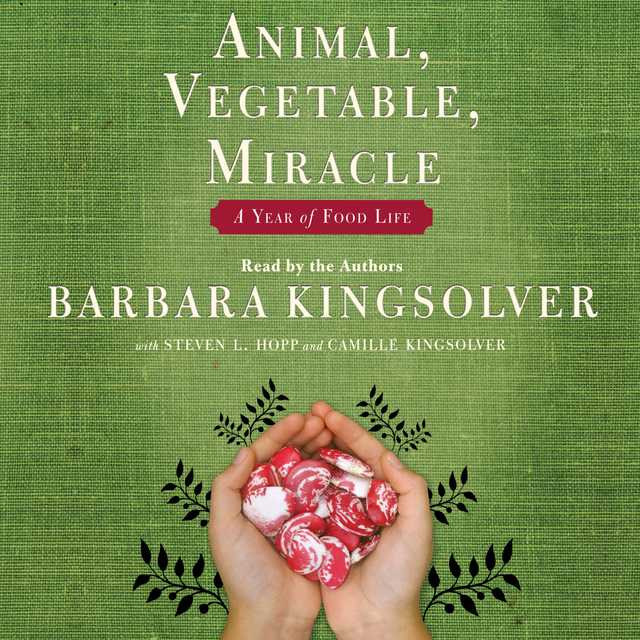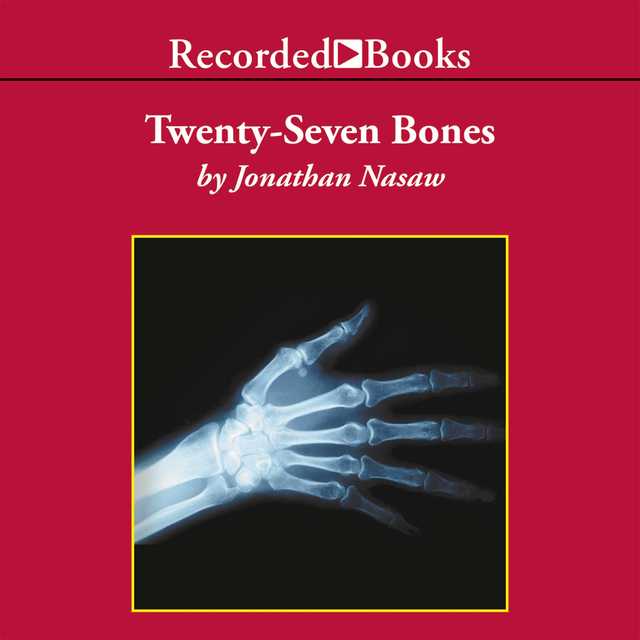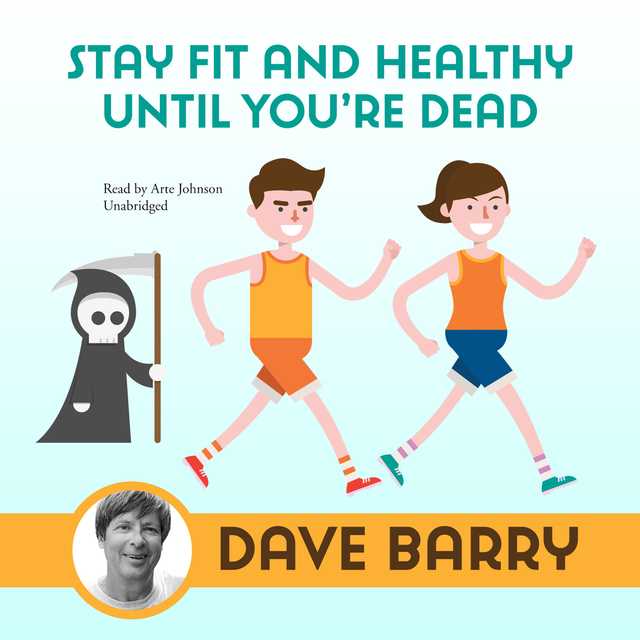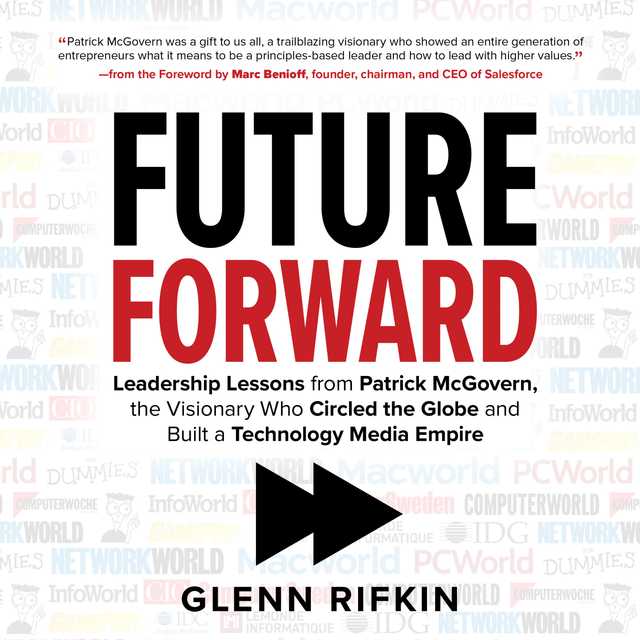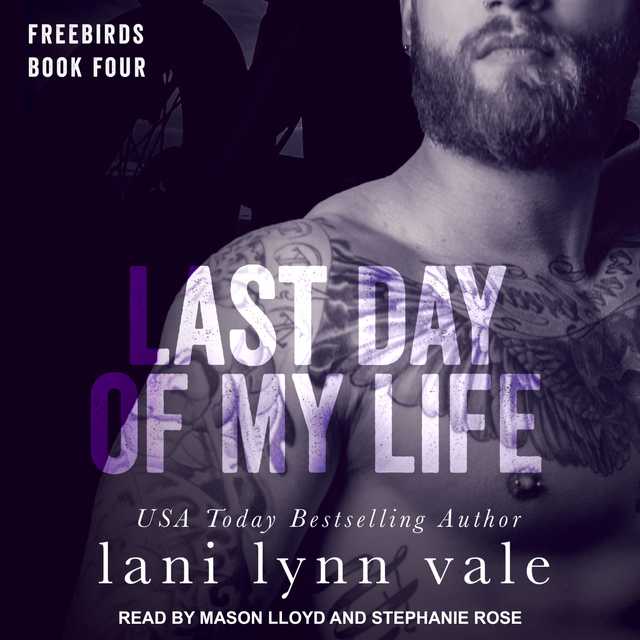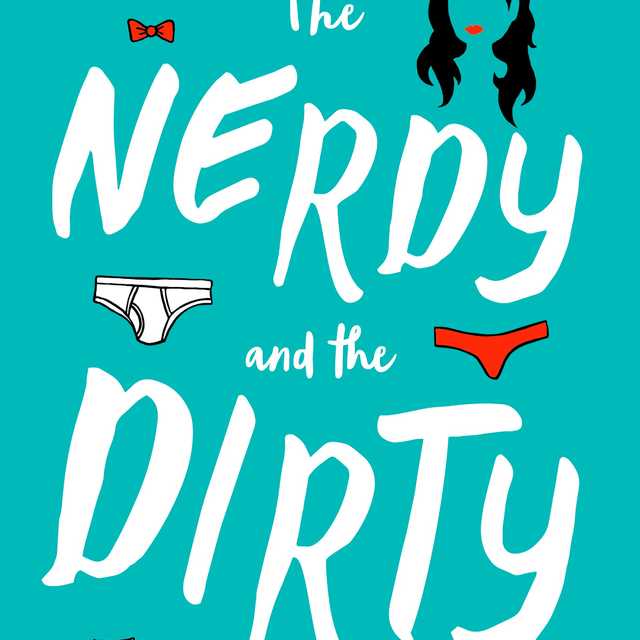Animal, Vegetable, Miracle Audiobook Summary
“A profound, graceful, and literary work of philosophy and economics, well tempered for our times, and yet timeless. . . . It will change the way you look at the food you put into your body. Which is to say, it can change who you are.” — Boston Globe
Barbara Kingsolver’s New York Times bestselling book describing her family’s adventure as they move to a farm in southern Appalachia and realign their lives with the local food chain
Hang on for the ride: With characteristic poetry and pluck, Kingsolver and her family sweep readers along on their journey away from the industrial-food pipeline to a rural life in which they vow to buy only food raised in their own neighborhood, grow it themselves, or learn to live without it. Their good-humored search yields surprising discoveries about turkey sex life and overly zealous zucchini plants, en route to a food culture that’s better for the neighborhood and also better on the table. Part memoir, part journalistic investigation, Animal, Vegetable, Miracle makes a passionate case for putting the kitchen back at the center of family life and diversified farms at the center of the American diet. It’s a modern classic that will endure for years to come.
Other Top Audiobooks
Animal, Vegetable, Miracle Audiobook Narrator
Barbara Kingsolver is the narrator of Animal, Vegetable, Miracle audiobook that was written by Barbara Kingsolver
About the Author(s) of Animal, Vegetable, Miracle
Barbara Kingsolver is the author of Animal, Vegetable, Miracle
More From the Same
- Author : Barbara Kingsolver
- Pigs in Heaven
- Homeland and Other Stories
- The Bean Trees
- The Lacuna
- Unsheltered
- Publisher : HarperAudio
- Abraham
- American Gods [TV Tie-In]
- Dead Ringer
- House of Sand and Fog
- Prey
Animal, Vegetable, Miracle Full Details
| Narrator | Barbara Kingsolver |
| Length | 14 hours 35 minutes |
| Author | Barbara Kingsolver |
| Category | |
| Publisher | HarperAudio |
| Release date | May 01, 2007 |
| ISBN | 9780061449932 |
Additional info
The publisher of the Animal, Vegetable, Miracle is HarperAudio. The imprint is HarperAudio. It is supplied by HarperAudio. The ISBN-13 is 9780061449932.
Global Availability
This book is only available in the United States.
Goodreads Reviews
Megan
May 19, 2014
This book gave me desires. Deep dark desires for...gardening. And making my own cheese. And doing more things from scratch. And doing them now.The thing is, these are all things I have aspirations to do anyway, but my way is rather slower than the way Barbara Kingsolver and her family approached trying to eat locally for a year. I'm trying to make small, long-term changes, one at a time, hopefully in a way that I'll stick to it. But it was fun to read about someone else's experiment, in mostly non-preachy tones, and, you know, quite a lot about turkey birth, sex, and death. Note: The rest of this review has been withdrawn due to the recent changes in Goodreads policy and enforcement. You can read why I came to this decision here.In the meantime, you can read the entire review at Smorgasbook
Elizabeth
January 27, 2008
You have to read this book. Not just because it conveys an important message about the sustainability and environmental impact of our foodways. Not just because its "Year in Provence"-style charm makes Appalachia sound as alluring as the French or Italian countryside (no euros required). But mostly because this is beautiful, tightly-strung writing about food and what it means to nourish ourselves. If you've read a certain amount of writing on food you know, sweet and delicious though it may be, that it can get cloying. A quick flip through Barbara's chapter on turkey butchering will cure you.In case you've had your head in the sand or don't live in the Bay Area or somewhere like it, here's the book's basic premise: Novelist Barbara Kingsolver and her professor husband pack up their two daughters and move from the New Mexican desert to a small farm in Virginia, where it rains and things grow, and after a bit of a weaning process that involves hard decisions about bananas, undertake a year of eating nothing but locally produced food. It's a lot of hard work, since they're doing most of the local production themselves. They make cheese and cook pumpkins and OD on asparagus. They have slaughtering parties. They come up with seasonal menus and recipes and share them with you.There's some sound political analysis of why and how our food chain has become a fossil-fuel eating monster that disserves developing economies around the world while eroding our health here at home. There's some preaching (oh well). There's a careful explanation of why and under what circumstances raising animals to eat them can be the best use of the planet's resources. There's a chick-hatching scene that will make you weep. I still can't keep my beloved husband from buying huge flats of Costco fruit grown halfway around the world, and I'm not giving up Italian truffles or French cheese or wine any time soon. So I can't be smug. But right now I have a big pot of soup simmering on the stove full of veggies from our local community-supported agriculture box, and I feel like we're living just a little bit more.
Calista
April 11, 2018
I enjoyed spending time with this book and the thoughts of the author. Barbara and her family decided to do an experiment and only eat what they raise and what is grown locally while it is in season for a year. It sounds so cutting edge and yet just 50 or so years ago this was the normal in the country. What a difference a half century makes.She really made me think about my food. I thought I eat healthy, but I eat things out of season and from all over the world. I have a huge carbon footprint with my food. I eat things all times of the year. I think not having a farm makes this difficult to do, but maybe that is all in my head. She has some amazing stories. Did you know that Turkeys have pretty much forgotten how to mate? It has been breed out of them. That seems crazy and it makes me feel the world will end soon. At these industrial farms all the animals are artificially inseminated. Crazy. She does help her Turkeys get their groove on.I love the way she gave food personality. I liked how she spoke of vegetarians. I didn't know this, but 1,000s of animals die from the pesticides used to grow plants, so you can't eat anything that isn't local which doesn't kill animals in some way. Listening to her book made me want to spend a year eating locally. I doubt it will happen for a while, but it sounds great. I learned so much about our food in this country. Farming is difficult and rewarding.Some conservative magazine put Barbara on the 100 most dangerous people trying to destroy America list. She talks about it in the story as she is making dinner covered in farm goo. A women living off the land really doesn't sound that dangerous. Maybe her ideas seem dangerous to those with their head in the sand - I don't know.This was a fantastic book and I can't live up to its message. I am glad the message is out there and maybe it will inspire more people to buy local. I know at least I can go to my farmers market now more often.
Larry
September 02, 2014
If you have ever grown asparagus, thought about growing asparagus or picked wild asparagus, you will enjoy the Waiting for Asparagus chapter. If you adore heirloom tomatoes that have a limited season, taste like real tomatoes, and probably have to be bought at your local farmers market, you will enjoy the chapter Springing Forward where you will not only read about heirloom seeds and their ilk, but also hear the author rant about genetically modified and hybrid corn and soybeans that have been developed to make money for large agribusiness companies. Also be prepared to listen up about hybrid tomatoes that have been genetically modified to travel and pack well; taste is totally secondary.And the book goes on with personal experiences of the Kingsolver family as they experimented with limiting themselves to local food, that is, to become locavores, and to learn about the history of agriculture and the things that threaten it today. It is a combination of storytelling that Barbara Kingsolver does very well and the nonfiction of food politics. You will read, probably with some disbelief, as Kingsolver tells about how she “grew up in a tobacco county” and goes on not only to defend but to support (maybe idealize is not too strong a word) the family farms that survived by growing a small cash crop of leaf tobacco. You will likely find other information that will surprise and confound and annoy you in the pages of this book. I think that encouraging thinking and debating is one of the good things about this book.The book presents a lot of introductory information. For the details you can go to the resource pages at the end of the book. Things you will get to read about in small doses:Mail order chicksRaising turkeys for foodCAFOs (concentrated animal feeding operations)Vegetarianism MorelsAmish dairy farmingFarm subsidies Harvesting farm animalsFair Trade productsGlobal warmingFood in school cafeterias Yes, as promised, turkey sexAt the end of the book you will find pages of organizations and resources about the issues and ideas raised in the book complete with URLs (internet addresses) so you can go investigating without any delay. There is also a web site for the book at http://www.animalvegetablemiracle.com/ . Kingsolver encourages you to learn and she believes that her knowledge and experience of being a locavore will serve you well, literally. She can be a little pushy and does have a disability of thinking she is right much of the time on this topic. She most likely is right! But some readers have felt she demeans them with her tone and certainty and facts. I mostly took it to mean that she is most dedicated to and enthusiastic about the politics of food and wants you to share both her concerns and excitement. One of the cook books she recommends is Local Flavors . And don’t miss the Locavore Reading List on GR: http://www.goodreads.com/list/show/46...I have had a few brushes with farm and locavore life so found the book reminiscent of days past in my life. This created a special enjoyment even though my experiences were all relatively short term and some time ago. I enjoyed reading Animal, Vegetable, Miracle enough to give it four stars. I think it will increase my desire to buy local food at the community market in season and to give more consideration to organically grown local food. Regrettably the local natural food store that has been in the Lynchburg area for the past two decades just closed, a victim of the down economy. However, the community market here is fairly substantial for seasonal produce and has local free range meat year round.
Renee
April 13, 2008
I was so excited to finally get my hands on this fantastic story about one family's year long experiment in growing & raising most of their own food. I love reading about people who think differently, act differently and live differently than the norm. I think the grow your own philosophy of this family is extreme for our culture but I am so attracted to it because it's a life lived with intention and deep conviction. In comparison I found our own family's efforts in supporting our local agriculture fairly piddly. This was a reality check since I can sometimes get on my high horse because I belong to a CSA and visit the weekly summer farmer's market. My basic criticisms of the book are two. Firstly, Kingsolver spends a fair amount of time writing about being a working mother. How she's managed to have a career and still can tomatoes. But from my farm & gardening experience I have a hard time believing that during the course of their grow-your-own year both she and her husband worked full time, yet she leaves readers with that impression. Or at the very least she doesn't exactly expound on her daily goings on except for what she's picking from the garden and special events celebrated with family and friends. What I want to know is how do you raise animals, plant, weed, pick, can and preserve the garden, butcher the animals and cook a home cooked meal every night? All while parenting, cleaning house, doing laundry, running errands, ya-da, ya-da, ya-da AND working full time?? These questions are never answered. And yet growing at least some of your own food is presented as achievable for the American family. I believe that unless the average American family undergoes a shift in priorities to spend less, drive less and work less the grow your own mentality is largely unrealistic. But hopefully books like Animal, Vegetable, Miracle will be a part of the movement that changes our popular fast food, fast life culture. So that realistically more families will choose to grow more gardens and shop for local, in season food. That brings me to the second criticism or perhaps observation. As a plant based eater living in Northern New England if I chose to eat only locally grown foods I'd eat a lot of potatotes and go crazy with summer blueberries (not a bad thing). Our family has chosen to base our diet on plants for improved immediate health and longevity, we want to be hiking with our grandkids. Eating a variety of foods from around the globe (at times) makes this possible. And for many, many people the only way to achieve the health they want in northern latitudes is to eat fruits and vegetables grown elsewhere. A bit of a conundrum if you believe in local sustainable agriculture - which I do. So, I'm thinking this one through. Trying to think of all the healthy foods which are grown here, how we can maximize our consumption of those and perhaps decrease the food we eat that is shipped from long distances.Overall, the book was a fantastic read . Kingsolver is engaging, funny, convincing and just an all round excellent writer. The book is an eat your local veggies & meat mantra but the narrative of her family keeps it personal and interesting.
Alison
June 19, 2015
I give this book 5 stars because its cause is very close to my heart. It is an excellent primer for sustainable, local food sourcing: it provides a good overview of the issues (including problems faced by small farms and the many dangers to global food supply and health posed by the industrial food complex) and a plan for gradually incorporating local and sustainable foods into your life (small steps, recipes, food plans, resources for learning more, and advice for approaching farmer's markets, CSAs, and even your supermarket). It covers the reasons why the country's foodways face imminent disaster, how you can help, and, most importantly for newbies, the many, many pleasures that can be had from responsible eating.Barbara Kingsolver chooses to take as pleasant, nonjudgmental and nondidactic approach as one can take to such important topics, because she is hoping to persuade people who are ignorant of or hostile to the issues. There are plenty of times I choose industrial food over sustainable--because I'm working too hard, broke, tired, craving Lays potato chips--but these are feeble excuses--and they are *immoral*. If you consider yourself a Democrat, liberal, environmentalist, humanist--or for that matter, a conservative who cares about the future of his or her children--you simply cannot rely on industrial food--including organic industrial food--for the majority of your diet. It is wrong, and there's no way to get around it. It was wrong to support the Iraq war (did anybody follow the news a few years ago that it has been made illegal in Iraq to save seeds? Iraqi farmers have been doing it for like thousands of years, growing crops from seed saved from previous harvests. But the U.S. has introduced a number of patented GM seeds, making U.S. farmer's aid dependent on use of the patented seeds, and made it illegal to save them. This creates a dependency on further purchases of seeds, as well as the chemicals needed to sustain them, and endangers nearby farmland that *hasn't* bought seed but gets contaminated by cross-pollination. We know that this has already happened on a huge scale in the U.S.), it was wrong to vote for Bush, and it is just as wrong to do most of your shopping at the supermarket--including Whole Foods--when you have alternatives--and in New York, at least, we DO have alternatives. It makes me furious to see this happening, and to do it myself when I lapse, in a way that should be more common--we should be angry, and we should talk about it, and we should not let ourselves off the hook. So obviously I'm passionate about this.Oh, back to the book. So, I think it's an important book, and I have Kingsolver's essay "Lily's Chickens" to thank for introducing me to these issues a few years ago. I learned some useful things abut aspects of food policy with which I was unfamiliar, and a lot of gardening tips. And I found it inspiring, and guilt-inspiring in a GOOD way, that is, the way that makes you change for the better, and not the way that makes you whine about how you have good reasons for being the way you are and that it's unfair of other people to expect you to change....anyway, I've already improved my buying habits since starting the book. But because I'm familiar with some of the material already, some things did stand out to me as mistakes. Her arguments about the bias against rural people, and her explanation of rural hostility to newcomers and difference as a protection against exploitation, were interesting and compelling, but her failure to acknowledge that we are not all white middle-class families, and that our "difference" can be construed in entirely different ways, as indeed a failure. (I'm not saying that only country people are racist or homophobic. But you can't defend the hinterlands as protective of some kind of essential American identity.) Her arguments in favor of meat eating, when she concentrated on the environmental benefits of sustainable grazing in nonarable land, were very good; they were NOT good when she defended meat eating as part of "civilization," and therefore okay.
Kate
January 30, 2008
** spoiler alert ** I have always been a fan of Barbara Kingsolver's work; her novels have a comfortable quality to them that makes me return a few times (except for Prodigal Summer, which I really didn't care much for). But once I discovered her nonfiction, my world changed. She was the first creative nonfiction writer who caught my eye and made me laugh, cry, and feel enraged. Had I not read her work, I doubt I ever would have been interested in writing creative nonfiction to begin with. I tell you all of this so that you can recognize any possible bias in the following statement: Animal, Vegetable, Miracle is a splendid book.The basic premise of the book is as follows: after much consideration of fossil fuel dilemmas, the struggling plight of local farmers, global warming, and an intense dedication to organic food processes, Kingsolver's family of four decided to go one year eating only things that came from within their county. They allotted each person one specialty item (her husband's was coffee; hers were spices like cinnamon, etc.) and bought bulk flour, but otherwise stuck more or less to the plan. They began in April and finished in April, and grew a massive amount of their own food (including poultry/eggs), supplementing it with farmers' market runs.AVM is strong for a number of reasons. Like her previous nonfiction works (High Tide in Tucson and Small Wonder), she strikes a solid balance between personal exploration and education. So in places she reflects on the entire experience--perhaps a couple pages on the appearance of asparagus and her personal and familial relationship with it, as well as a description of the patch they currently have--and then a few pages later, we learn about a particular facet of, say, the development of GM (genetically modified) seeds and the power they gave to agribusiness through copyright and patent laws. This fluidity is paced fairly well--there are only occasional places where she feels too preachy or gets too personally tangential, and they're tucked in with enough interesting details to make them almost unnoticeable.Be clear: this is not a how-to book (as she notes in the first couple chapters) and it is not necessarily designed to convince you that you need to do the same (she's not the local food police). Instead, she honestly highlights their struggles and joys, illuminates their reasoning for the whole project, throws in some fun anecdotes, and just generally expresses her passion for the whole subject.In spite of its 300+ pages, the book is quite accessible and unintimidating. Most chapters are 20 pages or less. The book is broken up even more (in a pleasant way) by informative sidebars from her husband Steven--which generally discuss resources, activist opportunities, laws, etc.--and the end-of-chapter pages by her eldest daughter Camille (now 19)--which include menu suggestions and a few recipes. Camille's sections are the only ones that get remotely "how-to," and that's only because of the recipes. The recipes are straightforward and, thus far, quite tasty (I've already made the Strawberry Rhubarb Crisp, which is hands-down one of the best summer desserts I've ever tasted or baked).I grew up in a family who grew nearly every piece of produce it consumed, but this book was still really educational and inspiring. Kingsolver brings an exquisite eye to detail to all her descriptions of plants, seeds, etc.--so much so that I actually ate asparagus for the first time in eons (I've always hated it) on Saturday. (Camille's suggestions on cooking it proved true--it was quite tasty.) Those of you who are already green thumbs will enjoy the insightful, humorous prose here; those of you whose thumbs might best be described as black can live vicariously through Kingsolver.And folks anywhere on that continuum might be inspired, and although this won't tell you how to do everything, it can point you in the right direction. The text itself mentions a lot of resources (cookbooks, seed sources, etc.), but there's a handy resource list at the end, including books, websites, organizations, and so forth. The plethora of cookbooks on turning local/farmers' market finds into delicious meals makes this book worth its weight in gold. You might also be prompted to try something really new for you--I had always been intimidated at the thought of making my own cheese, but the chapter on it and the resources provided has inspired me to attempt mozzarella, at least.Right now, the book is only available in hard cover; list price is $26.95 (Borders has it 20% off, which is where we got it). If that's too much for you, go check out The AVM Website to get recipes, more info on the book, a resource list, and some updates since the book's writing.
Clare
May 13, 2017
This is an excellent read. The language, spelling and grammar are highly professional, a joy to read.Barbara and her husband and daughters decided to embark on a year of growing their own food, raising their own poultry and buying local food from farmers. To this end they moved from their Arizona home to their country vacation home in the Appalachian mountains of southwest Virginia. They had prepared, of course, by renovating the house and outbuildings, planting asparagus beds and more. The hopeful and personal start turns rather abruptly into a discourse on why "we don't know beans about beans" as food production and distribution has been largely mechanised and factory swamped in the US. Keep reading. I enjoyed the lesson learnt from the first farmers' market they attended on a cold early spring morning. Nothing was growing so how would the family survive? They brought home a splendid haul and helped the farmers to stay in business. This continues through the early plantings, the earnest selection and purchasing of heritage breeds of chicken by Lily the youngest girl and entrepreneur in the making, and the home cooking full of aroma, taste and sizzle. Steven Hopp, Barbara's husband, contributes gourmet bread making daily and short articles on various facets of the food economy and health. Camille, the older daughter, recounts what it was like from the point of view of being a schoolgirl, then a student committed to eating for good and not for junk. She adds her favourite recipes. We also see a trip to friends and family including an Amish organic farm. Later the busy smallholders go for a trip to Italy. I found it very interesting that since tobacco, the mainstay of small farm economy and large farm wealth in Virginia, lost its subsidies, the small farmers have mostly taken to growing organic produce. This provides them with a premium product so they can gain a better price. Not everyone has a back forty acres to use to grow food. Not even an acre. But we can make better choices, support local goods instead of imported or long haul goods, and we can shop at farmers' markets. I love the sense of community shown.Poultry rearing is part of the self-sufficiency lifestyle, and if you don't like the account of killing and plucking for the freezer, skip ahead to where Barbara decides that her turkey flock, at nine months old among the oldest living turkeys in America, will have the chance to breed naturally. Heritage breeds - unlike the large white fowl fast-track raised for the oven - are hardier and physically able to mate; but no book on husbandry contained any instructions because turkeys have been artificially mated and reared since the middle of the twentieth century. This book is packed with information about American artificial food choices. Whether it's manufactured from every kind of byproduct and chemical, or hauled and frozen to be sold out of season, eventually this kind of food choice is not good for us nor for the Earth's finite resources. Even if you just read this book for the recipes, do read it. This is an unbiased review.
Caroline
May 26, 2015
Kingsolver writes about how she and her family decided to become self sufficient - growing all their own vegetables, and rearing chickens and turkeys. Along the way she also discusses the importance of buying food locally, and supporting local farmers where possible, the hidden costs of buying food world-wide, and the merits of small farms, free range animals and organic food. There are things she talks about that I can't do, but other things she discusses that I CAN do. Most of all she is a great writer - a poet and novelist as well as campaigner - and the book is a joyous read - a real celebration of community, kitchen and countryside.
Heather
December 03, 2007
This book is no revelation. Kingsolver herself says in the acknowledgments: "Everything we've said here, Wendell [Berry] said first, in a quiet voice that makes the mountains tremble." True that. That said, I am grateful to Kingsolver for writing a book on food ethics that my mom could read, because it's not a book on food ethics. For anyone who is already passionate about sustainable agriculture, this book will not teach you anything you don't already know. But, it may very possibly take its place as the religious tract of the sustainable movement: Here is a book I can give to all my friends that is accessible, practical, written by a household name, and may just have what it takes to change someone's mind.My favorite quote in the book receives that designation because it perfectly describes what I have been feeling the past few months but have not taken the time to articulate, even for myself. When I read it, it was like a little flash of light:"I share with almost every adult I know this crazy quilt of optimism and worries, feeling locked into certain habits but keen to change them in the right direction. And the tendency to feel like a jerk for falling short of absolute conversion. I'm not sure why. If a friend had a coronary scare and finally started exercising three days a week, who would hound him about the other four days? It's the worst of bad manners--and self-protection, I think, in a nervously cynical society--to ridicule the small gesture. These earnest efforts might just get us past the train-wreck of the daily news, or the anguish of standing behind a child, looking with her at the road ahead, searching out redemption where we can find it: recycling or carpooling or growing a garden or saving a species or something. Small, stepwise changes in personal habits aren't trivial. Ultimately they will, or won't, add up to having been the thing that mattered."This is the empathy, the hope, the encouragement we all need to turn and face a different direction, and make small steps forward.That, and the recipes are awesome.
Sherry
March 26, 2022
"AVM" is the book author Barbara Kingsolver, her husband, and oldest daughter co-wrote in their first full year of planting their own fruits and vegetables, and raising some of their own poultry, all sustainably. The family had been living in Tucson, but decided to move home to Appalachian southwest Virginia, back on a family farm. Kingsolver's husband wrote side bars about various political/environmental issues while Ms. Kingsolver wrote the diary itself. Daughter Camille wrote about eating sustainably from the viewpoint of a teenager. Daughter Lily was too young to sign a publishing contract, apparently, but had an end note in this 10th-anniversary edition. I liked that the chapters were divided according to the months of the year, beginning w/ the planting season in early March, steadily progressing until the next March. The trials, tribulations, icky weather, and yes, butchering, were all included. I enjoyed Ms. Kingsolver's turns of phrase, and will post some of my Kindle highlights. I read the Kindle edition of "AVM," but I really wish I'd purchased a physical copy, so I'd have easier access to some of the recipes included, although there is apparently a website that lists the recipes. I absolutely agree w/ Ms. Kingsolver that home-grown tomatoes, basil, green peppers, cherries, and peaches ALL taste SO much better when they are hand-harvested and prepared (the only "cr0ps" I've grown personally). My small cherries were so hard to gather, pit, and prepare, yet the taste of the cherry crisp was just out of this world! However, as much as I agree w/ Ms. Kingsolver about the satisfaction/great flavor from preparing foodstuffs grown and harvested by myself, Ms. Kingsolver's preaching about the evils of fossil-fueled transportation of food to grocery stores was just endless, and therefore knock my rating of "AVM" down to 4 stars. I am NOT going to give up my weekly bananas on my Sunday-morning waffles, but I will certainly eat more intentionally from now on, and am sold on the thought of eating locally and organically (if I can only convince myself of that while I'm at the grocery store...)
Most Popular Audiobooks
Frequently asked questions
Listening to audiobooks not only easy, it is also very convenient. You can listen to audiobooks on almost every device. From your laptop to your smart phone or even a smart speaker like Apple HomePod or even Alexa. Here’s how you can get started listening to audiobooks.
- 1. Download your favorite audiobook app such as Speechify.
- 2. Sign up for an account.
- 3. Browse the library for the best audiobooks and select the first one for free
- 4. Download the audiobook file to your device
- 5. Open the Speechify audiobook app and select the audiobook you want to listen to.
- 6. Adjust the playback speed and other settings to your preference.
- 7. Press play and enjoy!
While you can listen to the bestsellers on almost any device, and preferences may vary, generally smart phones are offer the most convenience factor. You could be working out, grocery shopping, or even watching your dog in the dog park on a Saturday morning.
However, most audiobook apps work across multiple devices so you can pick up that riveting new Stephen King book you started at the dog park, back on your laptop when you get back home.
Speechify is one of the best apps for audiobooks. The pricing structure is the most competitive in the market and the app is easy to use. It features the best sellers and award winning authors. Listen to your favorite books or discover new ones and listen to real voice actors read to you. Getting started is easy, the first book is free.
Research showcasing the brain health benefits of reading on a regular basis is wide-ranging and undeniable. However, research comparing the benefits of reading vs listening is much more sparse. According to professor of psychology and author Dr. Kristen Willeumier, though, there is good reason to believe that the reading experience provided by audiobooks offers many of the same brain benefits as reading a physical book.
Audiobooks are recordings of books that are read aloud by a professional voice actor. The recordings are typically available for purchase and download in digital formats such as MP3, WMA, or AAC. They can also be streamed from online services like Speechify, Audible, AppleBooks, or Spotify.
You simply download the app onto your smart phone, create your account, and in Speechify, you can choose your first book, from our vast library of best-sellers and classics, to read for free.
Audiobooks, like real books can add up over time. Here’s where you can listen to audiobooks for free. Speechify let’s you read your first best seller for free. Apart from that, we have a vast selection of free audiobooks that you can enjoy. Get the same rich experience no matter if the book was free or not.
It depends. Yes, there are free audiobooks and paid audiobooks. Speechify offers a blend of both!
It varies. The easiest way depends on a few things. The app and service you use, which device, and platform. Speechify is the easiest way to listen to audiobooks. Downloading the app is quick. It is not a large app and does not eat up space on your iPhone or Android device.
Listening to audiobooks on your smart phone, with Speechify, is the easiest way to listen to audiobooks.

